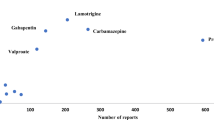Abstract
By analysing two patients initially diagnosed as Reye syndrome evidence is given that in some patients considered as having Reye syndrome, the syndrome is an escalation of symptoms due to viral disease and to unrecognized drug-induced encephalopathy, mainly by anti-emetics. A detailed drug history, considering all medication — not exclusively aspirin — taken during the full course of the illness is essential to differentiate between Reye syndrome and drug-induced symptoms. In addition, a critical analysis is presented of the four main case-control surveys that have lead to the proposal that salicylates are primary causative agents of Reye syndrome. In these surveys, medications given during the prodromal illness were adequately recorded, but other drugs given after the onset of vomiting have been overlooked or deliberately excluded. New epidemiological studies are needed, recording all drugs given to the patients throughout the full course of their illness until the moment of admission, in order to elucidate the mystery of Reye syndrome.
Similar content being viewed by others
References
Ayd FJ (1961) A survey of drug-induced extrapyramidal reactions. JAMA 175: 1054–1060
Bellman MH, Hall SM (1983) Aetiology of Reye's syndrome. Arch Dis Child 58: 670–672
Bonnel HJ, Beckwith JB (1986) Fatty liver in sudden childhood death. Am J Dis Child 140: 30–33
Casteels-Van Daele M (1970) Paroxysmal torticollis in infancy. Am J Dis Child 120: 88
Casteels-Van Daele M, Jaeken J, Van Der Schueren P, Zimmerman A, Van Den Bon P (1970) Dystonic reactions in children caused by Metoclopramide. Arch Dis Child 45: 130–133
Casteels-Van Daele M, Dobosz-Cyklis R, Van De Casseye W, Verbeeck P, Wijndaele L (1984) Refusal of further cancer chemotherapy due to antiemetic drug. Lancet I: 57
Clark JH, Fitzgerald JF (1981) Doubts relationship of salicylate and Reye's syndrome. Pediatrics 68: 466–467
Cottom DG, Newman CG (1966) Dystonic reactions to phenothiazine derivatives. Arch Dis Child 41: 551–553
Daniels SR, Greenberg RS, Ibrahim MA (1983) Scientific uncertainties in the studies of Reye's syndrome. JAMA 249: 1311–1316
Delay J, Deniker P, Thuiller J (1957) Similarity of the neurological complications of prochlorperazine with various postencephalitic disorders. Ann Med Psychol 115: 506–510
Editorial Reye's Syndrome (1982) Epidemiological considerations. Lancet II: 941–943
Editorial. Reye's Syndrome and Aspirin (1987) Epidemiological associations and inborn errors of metabolism. Lancet II: 429–431
Fulginiti VA, Brunell PA, Cherry JF, Ector WL, Gershon AA, Gotoff SP, Hughes WT, Mortimer EA, Peter G (1982) Committee on infectious diseases. Special report: aspirin and Reye syndrome. Pediatrics 69: 810–812
Gall DG, Barker G, Cutz E (1981) Doubts relationship of salicylate and Reye's syndrome. Pediatrics 68: 467–468
Glick T, Likosky W, Levitt L, Mellin H, Reynolds D (1970) Reye's syndrome: an epidemiologic approach. Pediatrics 46: 371–377
Gupta JM, Lovejoy FH (1967) Acute phenothiazine toxicity in childhood: a five-year survey. Pediatrics 39:771–774
Hall SM (1986) Reye's syndrome and aspirin: a review. J R Soc Med 79:596–598
Halpin TJ, Holtzhauer FJ, Campbell RJ, Hall LJ, Correa-Villaseñor A, Lanese R, Rice J, Hurwitz ES (1982) Reye's syndrome and medication use. JAMA 248:687–691
Hollister LE (1957) Complications from the use of tranquilizing drugs. New Eng J Med 257:170–177
Hurwitz ES, Nelson DB, Davis C, Morens D, Schonberger LB (1982) National surveillance for Reye syndrome: a five-year review. Pediatrics 70:895–900
Hurwitz ES, Barrett MJ, Bregman D, Gunn WJ, Pinsky P, Schönberger LB, Drage JS, Kaslow RA, Burlington DB, Quinnan GV, Lamontagne JR, Farweather WR, Dayton D, Dowdle WR (1987) Public health service study of Reye's syndrome and medications. Report of the main study. JAMA 257:1905–1911
Jabbour JT, Sheffield JA, Montalvo JM (1958) Severe neurological manifestations in four children receiving compazine (Prochlorperazine). J Pediatr 53:153–159
Linnemann CC, Shea L, Kauffman C, Schiff GM, Partin JC, Schubert WK (1974) Association of Reye's syndrome with viral infection. Lancet II:179–182
Linnemann CC, Shea L, Partin JC, Schubert WK, Schiff GM (1975) Reye's syndrome: epidemiologic and viral studies, 1963–1974. Am J Epidemiol 101:517–526
Mahoudeau D, Dubrisay J, Corcket F (1957) Transitory pseudotetanic syndrome following ingestion of phenothiazine derivatives. Bull Soc méd Hôp Paris 73:123–125
National Institutes of Health (1981) Diagnosis and treatment of Reye's syndrome. JAMA 246:2441–2444
Olson L, Bourgeois C, Cotton R, Harikul S, Grossman R, Smith T (1971) Encephalopathy and fatty degeneration of the viscera in northeastern Thailand. Clinical syndrome and epidemiology. Pediatrics 47:707–716
Orlowski JP, Gillis J, Kilham HA (1987) A catch in the Reye. Pediatrics 80:638–642
Reye RD, Morgan G, Baral J (1963) Encephalopathy and fatty degeneration of the viscera. A disease entity in childhood. Lancet II:749–752
Reynolds D, Riley H, LaFont D, Vorse H, Clarke Stout L, LeRoy Carpenter R (1972) An outbreak of Reye's syndrome associated with influenza B. J Pediatr 80:429–432
RS Working Group Aspirin in Foundation of America, Washington (1982) Reye syndrome and salicylates: a spurious association. Pediatrics 70:158–160
Starko KM, Ray CG, Dominguez LB, Stromberg WL, Woodall DF (1980) Reye's syndrome and salicylate use. Pediatrics 66:859–864
Thaler M, Hoogenraad N, Boswell M (1974) Reye's syndrome due to a novel protein-tolerant variant of ornithine-transcarbamylase deficiency. Lancet II:438–440
Waldmann RJ, Hall WN, McGee H, Van Amburg G (1982) Aspirin as a risk factor in Reye's syndrome. JAMA 247:3089–3094
Wilson JT, Brown RD (1982) Reye syndrome and aspirin use: the role of prodromal illness severity in the assessment of relative risk. Pediatrics 69:822–825
Author information
Authors and Affiliations
Rights and permissions
About this article
Cite this article
Daele, M.CV. Reye syndrome or side-effects of anti-emetics?. Eur J Pediatr 150, 456–459 (1991). https://doi.org/10.1007/BF01958420
Received:
Accepted:
Issue Date:
DOI: https://doi.org/10.1007/BF01958420




